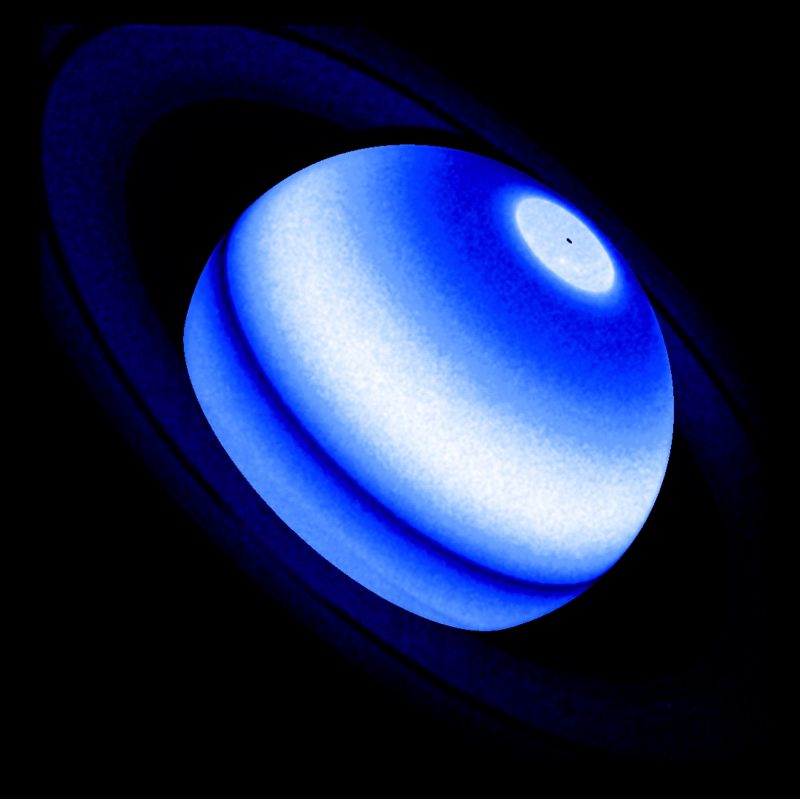
NASA published this original story on March 30, 2023. Edits by EarthSky.
The planet Saturn is famous for its opulent ring system, which you can see for yourself through a small telescope. Astronomers now say the rings are more dynamic than they look. They said that icy ring particles are raining down onto Saturn, and heating the planet’s upper atmosphere. They came to this conclusion after analyzing a collection of 40 years’ worth of Saturn observations, gleaned from four NASA space missions. Hubble Space Telescope observations helped tie together all the evidence, collected in ultraviolet light. These results might help astronomers learn if planets orbiting distant stars have similar ring systems. Distant planetary rings would be too far away to see. But ultraviolet light spectroscopy of distant planets might yield clues.
A discovery 40 years in the making
The secret has been hiding in plain view for 40 years. But it took the insight of a veteran astronomer to pull it all together within a year. Lotfi Ben-Jaffel of the Institute of Astrophysics in Paris and the Lunar and Planetary Laboratory at the University of Arizona used observations of Saturn from NASA’s Hubble Space Telescope and retired Cassini probe. In addition, he used data from the Voyager 1 and 2 spacecraft and the retired International Ultraviolet Explorer mission.
The discovery: Saturn’s vast ring system is heating the giant planet’s upper atmosphere. Scientists had never before seen this phenomenon in the solar system. It’s an unexpected interaction between Saturn and its rings that potentially could provide a tool for predicting if planets around other stars have glorious Saturn-like ring systems, too.
The telltale evidence is an excess of ultraviolet radiation, which scientists see as a spectral line of hot hydrogen in Saturn’s atmosphere. The bump in radiation means that something is contaminating and heating the upper atmosphere from the outside.
Last chance to get a moon phase calendar! Only a few left. On sale now.
Rain from Saturn’s rings
The most feasible explanation is that icy ring particles raining down onto Saturn’s atmosphere cause this heating. This could be due to the impact of micrometeorites, solar wind particle bombardment, solar ultraviolet radiation, or electromagnetic forces picking up electrically charged dust. All this happens under the influence of Saturn’s gravitational field pulling particles into the planet. When NASA’s Cassini probe plunged into Saturn’s atmosphere at the end of its mission in 2017, it measured the atmospheric constituents and confirmed that many particles are falling in from the rings.
Ben-Jaffel is the lead author of a paper published on March 30, 2023, in the peer-reviewed Planetary Science Journal. Ben-Jaffel said:
Though the slow disintegration of the rings is well known, its influence on the atomic hydrogen of the planet is a surprise. From the Cassini probe, we already knew about the rings’ influence. However, we knew nothing about the atomic hydrogen content.
Everything is driven by ring particles cascading into the atmosphere at specific latitudes. They modify the upper atmosphere, changing the composition. And then you also have collisional processes with atmospheric gasses that are probably heating the atmosphere at a specific altitude.
Seeing in UV light
Ben-Jaffel’s conclusion required pulling together archival ultraviolet-light (UV) observations from four space missions that studied Saturn. This includes observations from the two NASA Voyager probes that flew by Saturn in the 1980s and measured the UV excess. At the time, astronomers dismissed the measurements as noise in the detectors. The Cassini mission, which arrived at Saturn in 2004, also collected UV data on the atmosphere (over several years). Additional data came from Hubble and the International Ultraviolet Explorer, which launched in 1978, and was an international collaboration between NASA, ESA (European Space Agency), and the United Kingdom’s Science and Engineering Research Council.
But the lingering question was whether all the data could be illusory, or instead reflected a true phenomenon on Saturn.
The key to assembling the jigsaw puzzle came in Ben-Jaffel’s decision to use measurements from Hubble’s Space Telescope Imaging Spectrograph (STIS). Scientists used its precise observations of Saturn to calibrate the archival UV data from all four other space missions that have observed Saturn. He compared the STIS UV observations of Saturn to the distribution of light from multiple space missions and instruments. Ben-Jaffel said:
When we calibrated everything, we saw clearly that the spectra are consistent across all the missions. This was possible because we have the same reference point, from Hubble, on the rate of transfer of energy from the atmosphere as measured over decades. It was really a surprise for me. I just plotted the different light distribution data together, and then I realized, ‘Wow! it’s the same.’
A steady ice rain from Saturn’s rings
Four decades of UV data cover multiple solar cycles and help astronomers study the sun’s seasonal effects on Saturn. By bringing all the diverse data together and calibrating it, Ben-Jaffel found that there is no difference to the level of UV radiation. He said:
At any time, at any position on the planet, we can follow the UV level of radiation.
This points to the steady “ice rain” from Saturn’s rings as the best explanation. Ben-Jaffel continued:
We are just at the beginning of this ring characterization effect on the upper atmosphere of a planet. We eventually want to have a global approach that would yield a real signature about the atmospheres on distant worlds. One of the goals of this study is to see how we can apply it to planets orbiting other stars. Call it the search for ‘exo-rings.’
Bottom line: A new discovery indicates a steady, icy rain from Saturn’s rings affects the gas giant’s atmosphere. This insight could help lead to the discovery of rings around exoplanets.
Source: The Enigmatic Abundance of Atomic Hydrogen in Saturn’s Upper Atmosphere
Read more: Weather-watching on Jupiter and Uranus with Hubble











